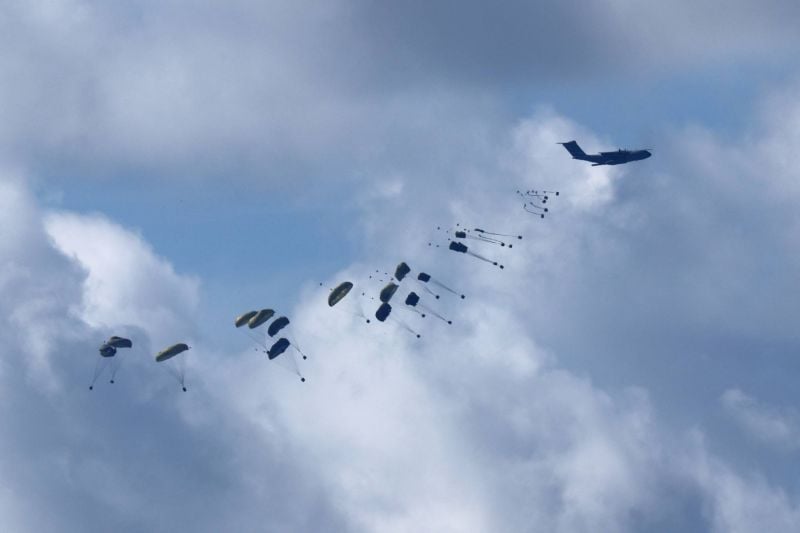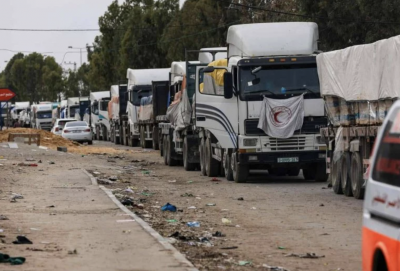
A military plane drops humanitarian aid over northern Gaza as seen from Israel's southern border with the Gaza Strip on March 7, 2024, amid the ongoing conflict between Israel and the Palestinian group Hamas. (Credit: Jack Guez/AFP)
During the final State of the Union address of his first term, US President Joe Biden announced that the US military would construct a "temporary pier" that would allow aid to more quickly flow into Gaza amid concerns that famine could break out in the besieged enclave.
By establishing this port, the US hopes that there will finally be a steady flow of aid entering Gaza to avoid what UN and health officials warn is a growing humanitarian catastrophe.
Here is what we know so far about the US plan.
Why is a temporary port needed?
Prior to the star of the war on Oct. 7, around 500 truckloads entered Gaza every day to provide assistance to a significant portion of the Palestinian population there. After the war started, the number of aid trucks entering Gaza plummeted.
Aid has been trickling in, primarily concentrated in the southern city of Rafah and limited by Israeli restrictions that prevent aid trucks from entering anywhere other than the Rafah Crossing on the Egyptian-Gazan border and at the Kerem Shalom Crossing in southern Israel.
Many of the aid convoys that managed to make it to the north have fallen victim to looting as the estimated 300,000 residents that remain in northern Gaza are starving and living on around one meal per day. A significant percentage of aid convoys trying to reach the north have been denied entry at an Israeli military checkpoint, according to aid organizations attempting to facilitate the deliveries. There have also been reports of aid convoys coming under fire from Israeli forces, a claim that Israeli authorities have denied.
This has led several countries — with the help of Jordan — to airdrop tens of thousands of meals into the north, although UN officials have said that this remains wholly insufficient compared to aid delivered by land.
"If nothing changes, a famine is imminent in northern Gaza," the World Food Program's deputy executive director Carl Skau told the UN Security Council on Feb. 26.
Despite demands by the US for Israel to increase aid flow into Gaza, there has not been any significant movement by the Israelis to facilitate this.
What did Biden say?
During his speech, Biden expressed his frustration with the Israeli leadership for their lack of effort to allow more aid into Gaza.
"To the leadership of Israel I say this — humanitarian assistance cannot be a secondary consideration or a bargaining chip," Biden said. "Protecting and saving innocent lives has to be a priority."
Because Israel has so far failed to increase the flow of aid into Gaza, Biden officially announced that he was ordering the US military to construct a "temporary pier" that would be used to "receive large ships carrying food, water, medicine and temporary shelters."
He added that "no US boots will be on the ground."
"This temporary pier would enable a massive increase in the amount of humanitarian assistance getting into Gaza every day," the president explained and once again reiterated his administration's position that "Israel must also do its part" in allowing more aid into Gaza and ensuring that "humanitarian workers aren't caught in the crossfire."
What is the timeline for the port?
According to a US official, who spoke on the condition of anonymity to The Washington Post, this will take several weeks to "plan and execute." The same official said that most of the US personnel needed to build and operate the port are already in the region or are on their way.
When asked The Post for more details on the plan, the Pentagon declined to comment, saying that more information would be provided on Friday.
The pier would be located off the coast of Gaza in the Mediterranean Sea.
How will the port work?
Aid looking to enter Gaza would first arrive in Cyprus where Israeli authorities would inspect the goods before approving it to enter the enclave. Israel has repeatedly said that all aid must undergo inspections before entering Gaza so that no materials that could be used by Hamas to build weapons enter the area. This has allowed Israel to block the entry of entire trucks because they contain, what the Israelis claim, are "dual purpose" materials that have both civilian and military uses. This practice has been heavily criticized by humanitarian workers.
From Cyprus, the aid will be loaded onto "large ships carrying food, water, medicine and temporary shelters."
Once at the pier, UN and aid organizations will take possession of the aid and distribute it throughout Gaza with Israel providing security arrangements.
According to a senior European Union official, the plan developed by the US, the EU and other countries calls for new aid shipments to Gaza sent by sea to begin in the next few days and for a private company to handle the logistics.
The Biden administration is looking to at least one American company, Fogbow, to coordinate deliveries to Gaza through the new maritime corridor using commercial ships, according to Gulf officials and people familiar with the plan.
Fogbow is made up of former US government, military and United Nations officials, according to the Wall Street Journal.
According to the US, this pier will help facilitate "hundreds" of aid convoys to enter Gaza on a daily basis.
What has the reaction been?
There has been little said by Israel so far about the plan.
An anonymous official told The Post that Israel "welcomes and fully supports" the plan and that there will be "full coordination between the two parties."
Yalda Hakim, an Israeli government spokesperson, told Sky News that Israel welcomed efforts by its allies to get aid to those in need and continued to insist that there are "no limits on the amount of aid that can go into Gaza."
Stephane Dujarric, spokesperson for UN Secretary-General Antonio Guterres, also welcomed the plan.
"We’ve been saying from the beginning, we need more entry points and we need a larger volume of aid to come in by land," the spokesperson stated.
While Sigrid Kaag, the UN coordinator for aid in the Palestinian territories, was pleased by the attempts to increase the aid flow to Gaza, she emphasized that bringing aid in through airdrops and the sea was not a "substitute" to the land convoys.
"It's easier, it's faster, it's cheaper, particularly if we know that we need to sustain humanitarian assistance to Gazans for a long period of time," she said.
The plan is likely to receive significant pushback from the far-right members of Israeli Prime Minister Benjamin Netanyahu's cabinet, some of whom have called for the reoccupation of Gaza and for settlers to return to the enclave after they were forced to leave in 2005.
No matter the level of Israeli opposition, the US official said that they "are not waiting on the Israelis."
